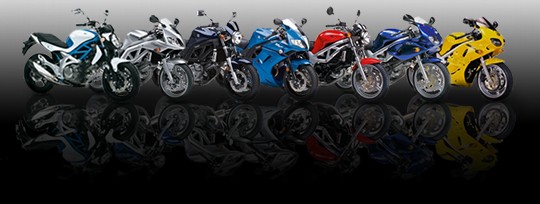 |
 |
|
|
#41 | |
|
Guest
Posts: n/a
|
Quote:
|
|

|
|
|
#42 |
|
Guest
Posts: n/a
|
Stuartyboy, I take it you are not being serious. If I didn't feel the change in speed (acceleration) then I probably wouldn't be interested in cars or bikes at all! When a car pushes you back in your seat or your bike pulls on your wrists what is it doing? I do believe it is accelerating. When it is pushing you back the most I think you would agree that it is accelerating the most. When these forces are experienced in your car/bike can be easily matched to the power chart. They do not relate to the torque curve. Last time I checked I don't have a built in torque sensor
Those who say that acceleration directly follows the torque curve need to go out for a drive/ride. Going by the torque curve on the SV the maximum torque is all over at 7,500rpm. So is acceleration all over at that point too? If that were the case shouldn't we all be changing gears soon thereafter? Please look at this link http://www.fjr1300.info/misc/torque-power.html and then tell me whether dynometers measure power or not. |

|
|
|
#43 | ||
|
No, I don't lend tools.
Mega Poster
Join Date: Jul 2003
Location: Skunk Works, Nth London
Posts: 8,680
|
Errrr...
It's all here*: Click Me For Embee's (yet again), Excellent Explanation Or to reeeeaaaaalllllyyyy simplify things and not get into a pointless argument: Torque: How hard you get pushed. Power: How far you get pushed. *As I said two pages ago. PS Quote:
Quote:
PPS There is some awful rubbish in this thread.
__________________
If an SV650 has a flat tyre in the forest and no-one is there to blow it up, how long will it be 'til someone posts that the reg/rec is duff and the world will end unless a CBR unit is fitted? A little bit of knowledge = a dangerous thing. "a deathless anthem of nuclear-strength romantic angst" |
||
|
|

|
|
|
#44 |
|
Guest
Posts: n/a
|
Mr Squid, Embees explanation tells us how torque is created and is interesting, but does not tell what the measurement is good for.
To simplify things like that is to just believe the marketing hype. Please don't. Please think about it for yourself, and relate what you feel when you are riding to the power and torque plots. Which one matches your experience? What else but opinion do we have on the internet? Jonboy's 2nd link is very flawed in its argument. The link I posted has a much better argument and more detail. Read them both, think about what they are saying, and it is easy to spot which one is correct. There is indeed lots of rubbish, and the most obvious is that you can feel the torque. |

|
|
|
#45 |
|
Member
Mega Poster
Join Date: Jul 2003
Location: Warwickshire
Posts: 2,804
|
 I don't understand why this subject always gets such a heated debate going. It's not a question of opinion or viewpoint, facts is facts, torque is torque, power is power. Back to basics, what combustion produces is gas pressure. How much pressure and how big the engine is manifests itself as torque. How fast the engine is running then gives the power. That's it. referring back to someone's thread, Dynos actually measure torque at the dyno shaft (via a load cell on a "torque arm" usually), and dyno shaft speed. From these you calculate power at the shaft. If you also measure the engine speed (if the engine isn't driving the dyno shaft directly as in a commercial test bed type arrangement) you can indirectly calculate the crankshaft torque (and if you know the swept volume you can then convert it back into BMEP). I'm not sure that you can actually measure power directly  , it's always a product of "force" and "speed" in some form or another, be it mechanical (torque x rotational speed, force x linear speed), electrical = Volts (like force or pressure) x Amps (like speed or flow rate), fluid as in pressure x flow rate etc. , it's always a product of "force" and "speed" in some form or another, be it mechanical (torque x rotational speed, force x linear speed), electrical = Volts (like force or pressure) x Amps (like speed or flow rate), fluid as in pressure x flow rate etc.Vehicle acceleration at any instant depends on how much tractive force is available and the mass of the vehicle (F=MxA). The tractive force available is the total tractive effort minus the force required to maintain a steady speed (drag). At a given speed the total tractive effort times the speed is the instantaneous power. Thus strictly speaking the acceleration at any instant depends on available power i.e. how much power the engine can deliver at that instant less the power required to overcome the drag. That'll depend on what speed the vehicle is doing and what gear you are in etc etc. In a vehicle what you actually feel is the reaction force that you have to provide on yourself in order to keep up with the vehicle accelerating, so it's a pull on your arms or push in the back of the seat. Sometimes the discussion gets confused between "feel" (in the literal sense) and "sense" as in what impression you get of what's happening. You sense a "torquey" engine by comparing what you feel with what you "know" (i.e. the engine is only running slowly but you're getting a lot of acceleration). If you couldn't see, hear, or feel the engine running, you wouldn't get the same impressions. .............I reckon |
|
|

|
|
|
#46 |
|
Member
Mega Poster
Join Date: Aug 2003
Location: HomeBound
Posts: 3,302
|
Thanks embee. Now I've got a headache
Cheers Ben |
|
|

|
|
|
#47 | |
|
Member
Mega Poster
Join Date: Jul 2003
Location: Warwickshire
Posts: 2,804
|
Quote:
Like any measurement, it's good for whatever you want to use it for. Technically we use BMEP (or IMEP, FMEP etc) more than torque or power, since it is a direct assessment of how good the engine is by contemporary standards. I know anything over 12Bar BMEP is pretty damn good by today's standards. 15 years ago, 11Bar was the benchmark. But that is of little or no interest to Joe Public who buys his new Loxley Lozenge GT. In empirical terms, there's a quite good correlation between "power (i.e maximum) to weight ratio" and 0-60mph acceleration times, for cars at least (bikes are at the extreme end where traction and technique are paramount). This is simply because when doing these tests the engine spends most of the time at close to max power through the gears so it's a "representative" value. Try plotting figures from Autocar or similar and you'll see they sit in a fairly well defined band, not surprisingly since it's basic physics. I don't really know what most people think of torque and power figures, not a lot probably. When working for a car manufacturer some years ago we did a survey of existing customers asking what they thought of different terminologies (4.0Litres, V8, straight-6, 250BHP etc) and basically it's a lot of mumbo-jumbo to most people, they are more interested whether it's Cordoba Red or Saturn Silver or how many cup-holders there are. |
|
|
|

|
|
|
#48 |
|
Guest
Posts: n/a
|
Embee, I think that heat of the debate relates to a general misunderstanding coupled with marketing brainwashing that torque=good.
My take on it is that the torque numbers and torque curve are nowhere near as meaningful to real world motorcycling as the shape of the power curve. Do you agree? The reaction force is related to G forces caused by the acceleration, and the acceleration is related to the power curve. I know that the power curve and torque curves are related, but why go one further step away? If you have the time, please do read the link I posted about the way dynometers measure power. |

|
|
|
#49 | |
|
Member
Mega Poster
Join Date: Jul 2003
Location: Warwickshire
Posts: 2,804
|
Quote:
I confess I wasn't considering inertia dynos, they are not normally an industrial item, though they are very attractive in simplicity and cost. Engine development requires much better repeatability than you can get from an inertia dyno so I was thinking absorbtion types. The discussion says you can't measure power directly, even an inertia dyno doesn't measure it directly since although you only measure rate of change of rotational speed, what you are also using in the calculation is the inertia of the dyno (which you measured before but stays as a constant), so strictly you still need 2 measurements although one of them stays constant. That's equivalent to measuring electrical power using an ammeter only on the basis that the voltage is constant, yes it does work but you need to have measured the voltage at some point. There was a method of "free acceleration" measurement devised many years ago for checking production engines, but the engine I was involved with at the time (6.75L V8 ) would free-accelerate so quickly without the torque converter attached that the errors became so large that the measurement was meaningless. It took half as long to open the throttle fully as it did for the engine to hit the rev limit. |
|
|
|

|
|
|
#50 |
|
Guest
Posts: n/a
|
Dotted........be honest, are you even more confused now
|

|
 |
|
|
 Similar Threads
Similar Threads
|
||||
| Thread | Thread Starter | Forum | Replies | Last Post |
| Please, someone, explain this! | thedonal | Idle Banter | 15 | 14-12-08 05:10 PM |
| can someone explain this please? | guzz316 | SV Talk, Tuning & Tweaking | 8 | 29-09-08 08:32 PM |
| Please explain this to me. | Pedrosa | Idle Banter | 12 | 03-11-07 12:26 PM |
| Anyone care to explain..... | Nexus242 | Idle Banter | 2 | 18-05-06 04:53 AM |
| explain pls | Wiltshire7 | SV Talk, Tuning & Tweaking | 26 | 16-11-04 11:29 PM |